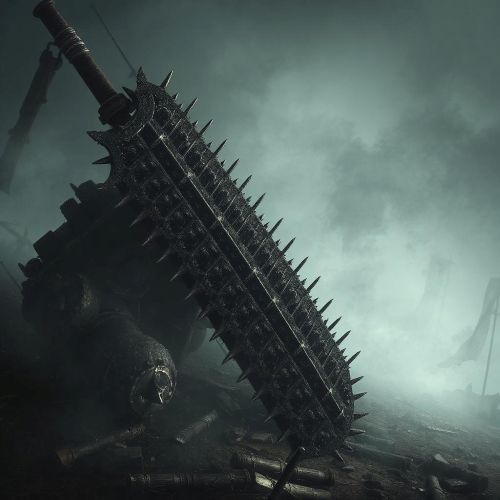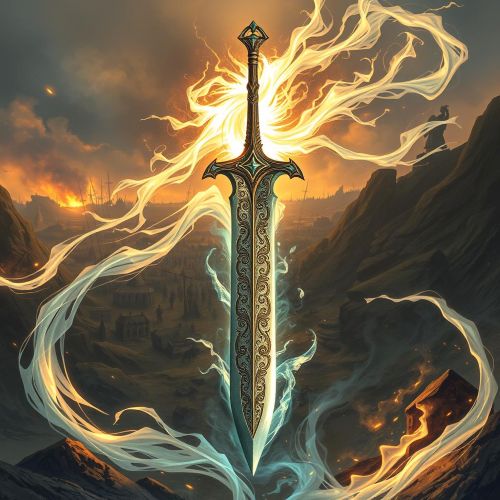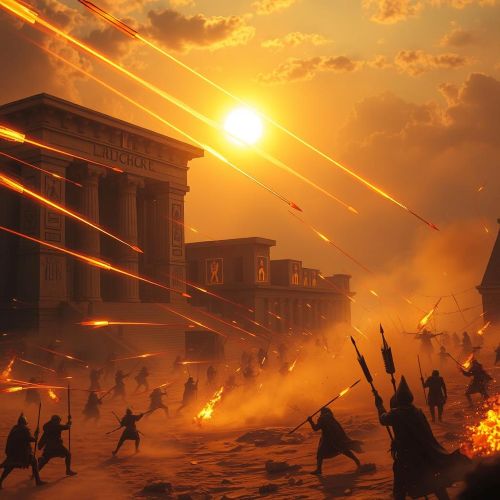Staff of Ra : The Power of the Sun
Staff of Ra
Introduction
The Staff of Ra stands as more than a weapon in Egyptian mythology; it embodies the divine authority of Ra, the revered sun god. Representing ultimate power, this mystical staff has fascinated scholars, storytellers, and enthusiasts for ages, seen as a tool that channels the sun’s life-giving energy. With its power to command light, life, and fire, the Staff was believed to grant its wielder unmatched influence over the forces of nature. Its presence in mythology is profound, yet its legacy extends beyond ancient stories, finding new life in modern culture where it continues to inspire awe. As one of the most mysterious and potent artifacts linked to Ra, the Staff symbolizes the god’s supreme authority and creative force, a testament to his role as the king of gods and the source of all life.
Origins
The Staff of Ra, a revered artifact in ancient Egyptian lore, carries with it profound significance rooted in the civilization’s deep spiritual beliefs. As the powerful symbol wielded by Ra, the sun god, this staff was said to channel the sun’s boundless energy, embodying both his divine authority and the order he brought to the cosmos. The ancient Egyptians viewed the sun as the ultimate life-giver, essential for fertility and the natural rhythms of day and night, and Ra, as the sun god, held a central place in this worldview. Temples, rituals, and prayers were dedicated to him, all celebrating his role in maintaining cosmic balance and sustaining life.
Ra is often portrayed as a falcon-headed figure, with a radiant solar disc above his head, emphasizing his dominion over the heavens and his connection to the sky. This imagery not only reinforces his power but also represents his dual nature as both a creator and a destroyer—qualities revered and feared by his followers. His emergence from the chaotic waters of Nun in various creation myths illustrates Ra’s role in bringing order from disorder, a common theme where deities are seen as the stabilizers of a tumultuous universe.
The Staff of Ra also shares a symbolic link with the Was-scepter, an emblem of control and authority that was typically adorned with a stylized animal head. This scepter, associated with deities such as Set and Anubis, symbolizes the power to impose order over chaos. The connection between Ra’s staff and the Was-scepter suggests a merging of physical and spiritual power, portraying the staff as not just a weapon but as a divine right and a symbol of ultimate sovereignty. The staff’s importance lies in its embodiment of Ra’s supreme authority, uniting earthly rule and cosmic governance.
In essence, the Staff of Ra stands as a timeless emblem of authority, one that transcends simple mythology. Its origin story and spiritual significance reflect the cultural values and beliefs that shaped ancient Egypt. Held by gods and pharaohs alike, it was more than a mere weapon; it represented their divine mandate to rule, protect, and bring order. This potent symbol of Ra’s power over creation and chaos underscores the depth and influence of Egyptian mythology on its society and beyond.
Think you know your myths and legends? Dive into the world of ancient stories and test your knowledge with our engaging quizzes on Mythlok!
Powers
The Staff of Ra was renowned for its awe-inspiring powers, each reflecting a facet of Ra’s supreme role:
Harnessing Solar Power: The Staff was said to channel the sun’s raw energy, wielding beams of light and heat that could pierce through darkness or devastate enemies. It acted as a direct link to the sun, drawing on its radiance to defend and empower.
Balancing Creation and Destruction: As an artifact of the creator god, the Staff carried dual abilities—it could foster life and order, yet it also held the terrifying power to destroy anything opposing Ra’s will. This balance represented Ra’s role as both a nurturer and protector of cosmic order.
Symbol of Divine Rule: More than just a weapon, the Staff symbolized Ra’s authority over gods and humans alike. It was a key emblem of Ma’at, the concept of universal harmony, and ensured that Ra’s influence would maintain the delicate balance between chaos and order.
Power of Transformation: The Staff of Ra could shift forms to meet its wielder’s needs. It was said to take two main shapes:
1. A sleek, golden blade-like form suited for close combat, symbolizing Ra’s readiness to face threats head-on, especially his eternal battle against Apophis, the god of chaos.
2. A larger, radiant form, pulsating with solar energy, reserved for divine beings and underscoring its godly origins and purpose.
Vanquishing Darkness: With its divine power, the Staff could annihilate evil and chaos, purging dark entities that threatened the balance Ra upheld. Its fire was particularly potent against sinister forces, making it an indispensable tool in maintaining cosmic order.
Owners/Users
While the Staff of Ra is most closely linked with Ra, the sun god, its legacy extends through several other prominent figures in Egyptian mythology:
Ra: As the original wielder, Ra relied on the Staff to uphold order and protect the universe from the forces of chaos, particularly during his journey across the heavens each day.
Osiris: The god of the afterlife and renewal, Osiris, was occasionally associated with the Staff, symbolizing the seamless flow between life, death, and rebirth. His connection to the Staff highlights the continuity of Ra’s power even in the realm of the afterlife.
Set: Known for his turbulent nature, Set once seized the Staff, using it to wield destruction and challenge his brother Osiris. This temporary control reflects the ongoing tension between chaos and order in Egyptian myth.
Horus: Avenging his father Osiris, Horus is also linked to the Staff. In his quest to reclaim balance, he restored the Staff to Ra, underscoring the cycle of divine justice and the restoration of cosmic order.
Pharaohs: As earthly embodiments of Ra’s authority, pharaohs were often depicted holding the Staff, symbolizing their divine connection to Ra and reinforcing their sacred right to rule. Through this, the Staff became not only a divine tool but a symbol of the pharaoh’s role as guardian of Ma’at, or cosmic balance.
Instances used
The Staff of Ra holds a central place in Egyptian mythology, not only as a symbol of Ra’s divine authority but as a powerful force featured in key myths and legends:
Ra’s Cosmic Battles: One of Ra’s enduring struggles involved his nightly confrontation with Apophis, the serpent of chaos. As the sun god navigated the underworld each night, he wielded the Staff to ward off Apophis, ensuring the sun’s renewal at dawn. This nightly victory symbolized the triumph of light over darkness and order over chaos.
The Creation Story: In creation myths, the Staff played a vital role as Ra used it to establish order from the primordial chaos, marking the beginning of life and the cosmos. By wielding the Staff, Ra brought harmony and set the foundations for the natural world, underscoring its importance in Egyptian cosmology.
Osiris and Horus Legend: In the story of Osiris, the Staff symbolized Horus’s rightful authority as he sought to avenge his father and restore order to Egypt. Horus’s association with the Staff reinforced the idea of divine inheritance and the continuity of justice and leadership in Egyptian beliefs.
Modern Cultural Legacy: Today, the Staff of Ra captivates audiences through pop culture, notably in films like Indiana Jones and the Raiders of the Lost Ark. Here, the Staff is portrayed as a key to unlocking ancient mysteries, blending mythological symbolism with modern adventure. The headpiece, in particular, is iconic for its role in revealing hidden truths, showcasing how the Staff of Ra continues to inspire and fascinate as both a symbol of ancient wisdom and a tool for discovery.
Source
Wikipedia. (n.d.). Ra. Retrieved from https://en.wikipedia.org/wiki/Ra
Ancient History Encyclopedia. (n.d.). Ra. Retrieved from https://www.ancient.eu/Ra/
Britannica. (n.d.). Ra. Retrieved from https://www.britannica.com/topic/Ra
Wilkinson, Richard H. (2003). The Complete Gods and Goddesses of Ancient Egypt. Thames & Hudson.
Pinch, Geraldine. (2004). Egyptian Mythology: A Guide to the Gods, Goddesses, and Traditions of Ancient Egypt. Oxford University Press.
“Spear of Ra – Gods of Egypt Wikia – Fandom,” Gods of Egypt Wikia, October 29, 2024.
“What’s with the staff thingies that Anubis, Horus, Ra, Sekhmet, Thoth …,” Reddit, June 16, 2023.
Frequently Asked Questions
What is the staff of Ra?
In Egyptian mythology, Ra, the sun god and king of the gods, is frequently depicted holding a staff, often alongside the ankh (symbol of life). This staff is primarily a symbol of authority, power, and dominion. It signifies Ra’s role as the supreme ruler of the cosmos and his control over the natural order. While not typically associated with specific magical powers in the same way as some other mythological staffs, the staff of Ra embodies his divine status and the immense power he wields as the sun god and creator figure.
What is Ra's staff called?
While the sun god Ra is consistently depicted holding a staff as a symbol of his authority and power in Egyptian mythology, this staff doesn’t have a specific, widely recognized name. It’s simply referred to as his staff or scepter, emphasizing his dominion as the king of the gods and ruler of the cosmos. Sometimes, it is depicted as a Was-scepter, a common symbol of power and dominion associated with various deities and the pharaohs.
What are the powers of the staff of Ra?
In Egyptian mythology, the staff held by Ra, often depicted as a Was-scepter, primarily symbolizes his supreme authority, dominion over the cosmos, and his role as the king of the gods and sustainer of life. While not typically attributed specific magical powers in ancient texts, it embodies his inherent divine power and control over the natural order. The Was-scepter association further reinforces its representation of power and the maintenance of cosmic harmony (Ma’at), visually solidifying Ra’s preeminent status within the Egyptian pantheon.
How tall is the staff of Ra?
In Egyptian mythology, the staff of Ra, often associated with the Was-scepter, doesn’t have a fixed height mentioned in ancient texts. Its size would likely vary in depictions, primarily serving a symbolic purpose rather than a practical one. However, real Was-scepters have been found with varying lengths, some reaching up to two meters (around 6.5 feet), as one exceptional example discovered near Naqada. Therefore, if we were to imagine a physical representation of Ra’s staff based on existing Was-scepters, it could be quite tall, potentially around that height.
Is Indiana Jones based off a real story?
Indiana Jones is not based on a single real story but rather draws inspiration from the lives and adventures of several historical figures, including archaeologists like Hiram Bingham III, Roy Chapman Andrews, and Percy Fawcett, who were known for their daring expeditions and discoveries.





